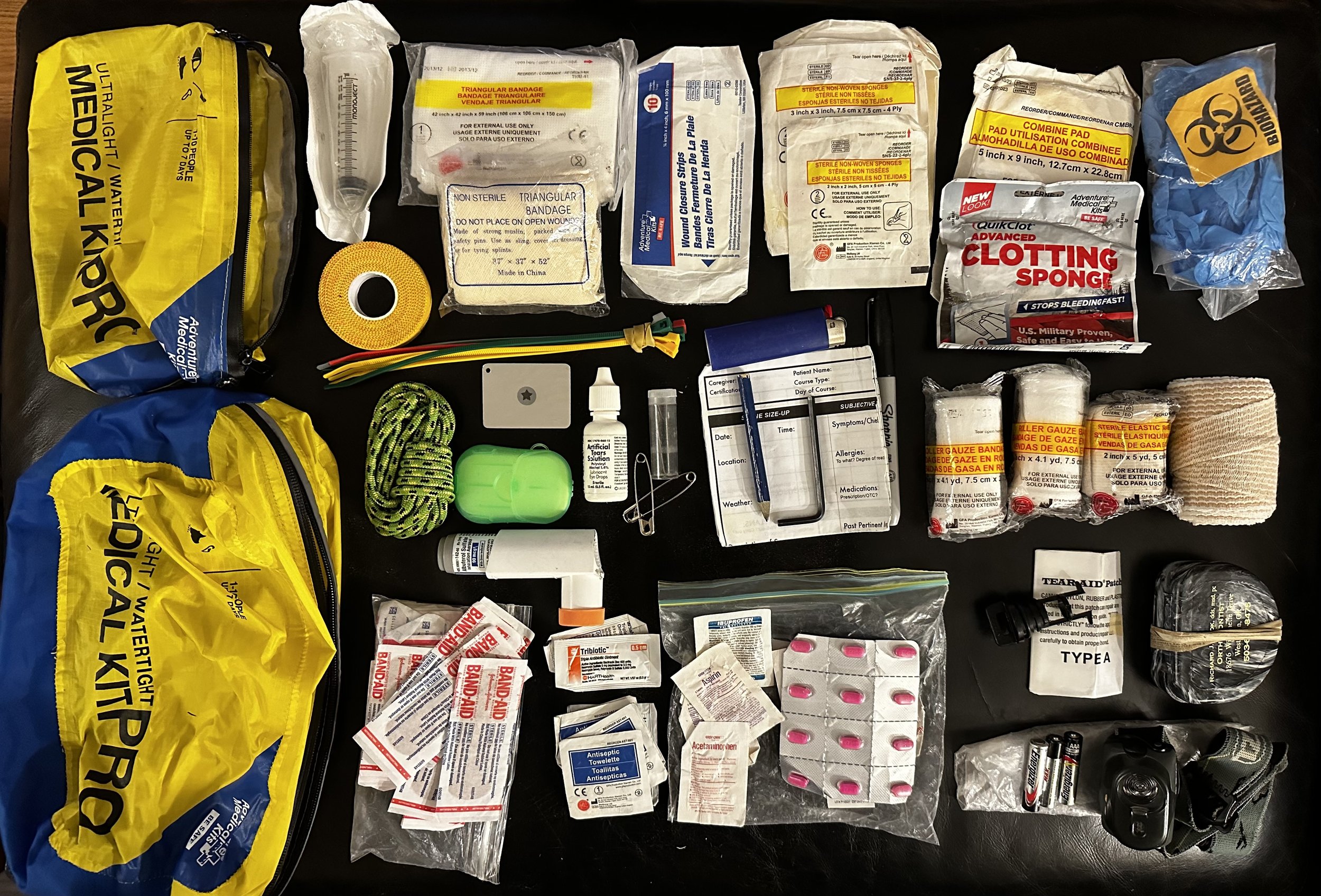What’s in my Drybag
by Chris Meinke, Safety Chair
I learned a long time ago that I am not good at improvising repair gear, first aid supplies, and rescue gear. I am terrible at making fire with sticks and friction. I don’t know how to synthesize Benadryl from elements found in nature. And, past experience has shown that my night vision isn’t good enough to prevent a broken ankle from a misstep.
I also learned that I am willing to carry a little extra to avoid the need to be creative with my solutions in the backcountry. For a little background, I’ve spent the last 20 years honing my skills as a mediocre outdoorsperson. I started with backpacking and worked my way into more vertical terrain, learning the basics of mountaineering and rock climbing. As I became more knowledgeable, I realized that I could carry less and use some items for multiple purposes. Once I moved to Corvallis, OR to finish college, I took several more classes related to the outdoors. Their Adventure Leadership Institute has to be one of the finest outdoor education programs at a university, and I took advantage of that resource to become a Wilderness First Responder, learn Swiftwater Rescue through their raft guide school, and take a class on Wilderness Living Techniques.
The thing that has become abundantly clear to me is that my skills are pretty useless without the right tools. The class on Wilderness Living techniques culminated in a weekend trip in the Oregon coast range during the winter, where we were required to improvise a shelter for two nights. We each had a partner, and we could carry as much or as little gear as we wanted. My partner and I decided that rain gear (it was pouring rain for several days straight), a large knife, and a lighter would be all that we would need. We built a little A-frame shelter and were able to make a fire, but the fire required constant attention and I didn’t sleep for two days.
I learned one of my most important lessons that weekend, which was re-iterated by the instructor. He told us, “only carry as little as you're willing to survive without.” I couldn’t have survived without rain gear and would probably have gone hypothermic without the fire and a knife to build a shelter. But, I didn’t have many of the other Ten Essentials that I consider critical pieces of gear. If you’re not aware of the Ten Essentials (which can be more like 10+ essentials depending on activity, length of trip, etc.), I highly recommend going on a Google rabbit-hole searching spree.
Chris’ drybag is a Watershed brand, Ocoee model.
As paddlers, we often equate a day trip with being more accessible, but we can easily find ourselves trapped in a box canyon with an injury just a stone's throw from a road. Sure, I can cut up my base layers as a substitute for gauze or to make a sling, but I don’t know how to make duct tape from a douglas fir tree, so I’m going to carry duct tape. Maybe I carry too much gear for some situations, but I don’t even notice it anymore, and I consider it insurance for worst case scenarios that I hope to never encounter.
I carry all of the following, regardless of season or boat. Yes, I fit this in my smallest play boat. On a multi-day trip, I carry extra boat repair gear and first aid, but this kit goes with me every paddling day, along with the skills to use them.
Chris’s life jacket and what he carries in/on it.
In/on my PFD:
Outside
River knife
Whistle
Tow tether (river dependent)
Locking carabiner
Inside
Candy bar
Garmin In-Reach
Duct tape
15 ft of 1-in. tubular webbing + locking carabiner
2 prussiks
Pulley
2x locking carabiner
Folding pointed knife
Zip ties
Eye drops
SPF chapstick
Extra nose plugs
Hair tie
Wet wipe
Contents of Chris’ drybag.
In my Watershed Ocoee dry bag:
Ultralight synthetic puffy jacket
Beanie
Fleece gloves
Progress capture pulley
Locking carabiner
Sterling hollowblock prussik
First aid/Repair kit
Nitrile gloves + plastic bag
Clotting sponge (medicated for stop bleeding)
Lots of sterile gauze and sponges
2x Steristrips
2x Triangular bandages
2x Elastic bandage
2x roll of sterile gauze
Small syringe
Medical tape
Metolius climbing tape is the best
Safety pins
Tweezers
Eye drops
Medications
Benadryl
There is no substitute for an allergic reaction
Ibuprofen
Acetaminophen
Aspirin
Loperamide hydrochloride (Imodium)
Antiseptic towelettes
Triple antibiotic ointment
Flexible fabrics bandages
Personal inhaler
SOAP Note + pencil
Sharpie
Soap sheets
Signaling mirror
Zip ties
5 mm cord (12 ft)
Allen key
Headlamp (batteries stored externally)
Pocket saw
Lighter
Type A Tear-Aid patches
Gasket or dry suit repair
Extra drain plug
Epipen would make a nice addition if you have a bee or other allergy
Contents of Chris’ first aid kit.



